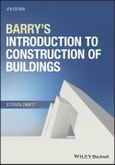An authoritative, well-established, comprehensive, practical, and highly illustrated guide to construction practice
Based mainly on domestic and residential buildings - and filled with extensive illustrations throughout - this concise text is the ideal introduction to the subject of building construction. It provides the basic material that readers need in order to understand the construction process for the majority of low rise buildings. The book explains construction technology through the key functional and performance requirements for the main elements common to all buildings. With a strong focus on building efficiency and meeting the challenges posed by limiting the environmental impact of buildings, and new “at a glance” summaries allowing you to grasp the salient points of each chapter, readers will find the text fully up to date with the latest building regulations and construction technology.
Barry’s Introduction to Construction of Buildings, Fourth Edition starts by taking an in-depth look at the construction process and general principles of construction. It then offers comprehensive chapter coverage of site analysis, set-up, drainage and scaffolding; ground stability and foundations; floors, walls, doors, windows, roofs, stairs, and ramps; surface finishes; internal environment and energy supply; and water supply and sanitation.
- Deals with design, technology, site assembly, and environmental issues of domestic and residential buildings
- Thoroughly updated, with particular attention paid to the concept of building efficiency and improved integration of the topics covered to match current student needs
- New “at a glance” summaries at the beginning of each chapter
- A companion to Barry's Advanced Construction of Buildings, Fourth Edition
Barry’s Introduction to Construction of Buildings is an excellent source of information for undergraduate students and those working towards similar NQF level 5 and 6 qualifications in building and construction.
Table of Contents
Preface ix
How to Navigate this Book xi
1 Introduction 1
1.1 The construction process 1
1.2 The function and performance of buildings 2
1.3 Building: the (de‐carbonised) product 5
1.4 Responding to climate change 6
1.5 General principles of construction 8
1.6 Regulations and approvals 11
1.7 Making choices and sources of information 12
Chapter 2 AT A GLANCE 15
2 Site Analysis, Set‐Up, Drainage and Scaffolding 17
2.1 Site analysis 17
2.2 Site set‐up and security 30
2.3 Site drainage 34
2.4 Foul drainage 41
2.5 Scaffolding 68
Chapter 3 AT A GLANCE 91
3 Ground Stability and Foundations 93
3.1 Bedrock and soil types 93
3.2 Ground stability 100
3.3 Foundations: Functional requirements 104
3.4 Foundation construction 116
3.5 Strip foundations 126
3.6 Pad foundations 137
3.7 Raft foundations 145
3.8 Short‐bored pile foundations 153
3.9 Precast pile and beam foundation systems 155
Chapter 4 AT A GLANCE 157
4 Floors 159
4.1 Functional requirements 159
4.2 Ground‐supported concrete floor slab 162
4.3 Suspended concrete floor slabs 170
4.4 Suspended timber ground floors 176
4.5 Reinforced concrete upper floors 179
4.6 Timber upper floors 184
4.7 Floor finishes 193
Chapter 5 AT A GLANCE 203
5 Loadbearing Walls 205
5.1 Functional requirements 205
5.2 Walling materials 212
5.3 Mortar 223
5.4 Bonding bricks and blocks 227
5.5 Damp‐proof courses (DPCs) 233
5.6 Solid wall construction 241
5.7 Cavity wall construction 270
5.8 Internal and party walls 298
5.9 Straw wall construction 299
5.10 Earth wall construction 305
Chapter 6 AT A GLANCE 311
6 Roofs 313
6.1 Functional requirements 313
6.2 Pitched roofs 317
6.3 Pitched roof coverings 338
6.4 Sheet metal covering to low‐pitched roofs 356
6.5 Thermal insulation to pitched roofs 359
6.6 Flat roofs 365
6.7 Timber flat roof construction 367
6.8 Concrete flat roofs 384
6.9 Thermal insulation to flat roofs 387
6.10 Parapet walls 392
6.11 Green roofs 396
6.12 Roof drainage 400
Chapter 7 AT A GLANCE 409
7 Windows 411
7.1 Functional requirements 411
7.2 Window types 436
7.3 Window frames 446
7.4 Glass and glazing 473
7.5 Hardware 488
7.6 Window cills 489
Chapter 8 AT A GLANCE 497
8 Doors 499
8.1 Functional requirements 499
8.2 Door types 504
8.3 Door frames and linings 525
8.4 Hardware 540
Chapter 9 AT A GLANCE 547
9 Stairs and Ramps 549
9.1 Functional requirements 551
9.2 Materials, terms and definitions 553
9.3 Types of stairs 562
9.4 Timber staircases 563
9.5 Stone stairs 574
9.6 Reinforced concrete stairs 576
9.7 Structural glass stairs 580
9.8 Ramps 581
Chapter 10 AT A GLANCE 585
10 Surface Finishes 587
10.1 Functional requirements 587
10.2 Wall and ceiling finishes 589
10.3 Skirtings, architraves and kitchen cabinets 604
10.4 Tiling to walls 608
10.5 Painting and decorating 609
Chapter 11 AT A GLANCE 617
11 Internal Environment and Energy Supply 619
11.1 Principles and performance requirements 619
11.2 Heat loss calculations 621
11.3 Indoor climate control 632
11.4 Energy sources 636
11.5 Solid fuel-burning appliances 641
11.6 Domestic gas installations 657
11.7 Domestic electrical supply and installations 662
11.8 Artificial lighting 680
11.9 Testing and monitoring thermal performance 683
Chapter 12 AT A GLANCE 689
12 Water Supply and Sanitation 691
12.1 Cold water supply and distribution 691
12.2 Hot water supply and distribution 700
12.3 Water services to multi‐storey buildings 708
12.4 Pipes for water supply 717
12.5 Sanitary appliances 721
Index 743








